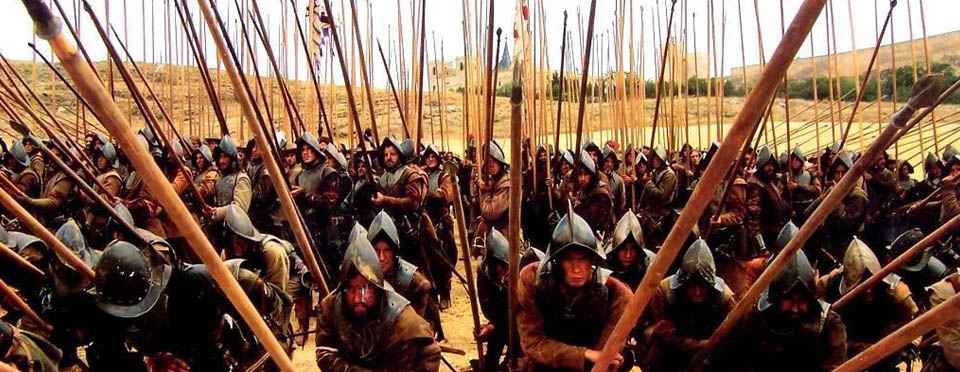Medieval military orders were more than soldiers of Christ. They were powerful, hierarchical, and disciplined organizations that combined monastic life with the art of war.
Its influence was not limited to the battlefield, but extended to urban planning, architecture, and military technology of the Middle Ages.

Distinctive weapons: between functionality and symbolism
In the Crusading context, all three orders adopted similar armaments based on the model of the medieval European knight. However, each order developed its own variations and preferences.
The Templars , known for their strict discipline, preferred proven weapons.
Its most recognizable symbol was the double-edged, broad-bladed straight sword with a simple cross, ideal for close combat. This sword was often accompanied by the almond-shaped shield (called the Norman shield), decorated with the characteristic red cross on a white background.
They also used spears, maces and war knives; the weapons were considered property of the order, not the individual, and had to be carefully looked after.
The Hospitallers , although initially focused on healthcare functions, eventually adopted a collection of weapons very similar to the Templars.
Their sword was also straight, but they often incorporated the eight-pointed cross on the hilt or scabbard, as a symbol of their identity.
They were known for wearing reinforced chain mail and adopted the use of longbows in certain contexts, especially in the defense of fortresses such as those of Rhodes.
Its shield, black with a white cross, was as emblematic as its armament.
The Teutonics , of Germanic roots, were distinguished by a more robust style adapted to the climates of northern Europe.
Although they also used the straight sword, they sometimes opted for heavier versions, such as the bastard or hand-and-a-half sword, to respond to warfare in forests and castles.
Their shield displayed a black cross on a white background, and their armament also included maces, axes, and crossbows, weapons more common in conflicts in northeastern Europe.
In short, they all used similar weapons due to their functionality, but the details in decoration, materials, and design responded to their cultural roots, area of action, and military context.

Medieval fortresses and castles: defensive and symbolic power
The places where these orders lived and operated were not just religious or military centers: they were symbols of power, strategic nodes, and architectural expressions of their time.
The Templars were distinguished by building simple but well-fortified castles at strategic points in the Holy Land.
Krak des Chevaliers, although later occupied by the Hospitallers, was initially Templar.
Another notable fortress was Safed, in Galilee, one of the most advanced in military engineering of its time. Its structures featured circular towers, thick walls, and defense systems in depth.
In Europe, its network of encomiendas extended from England to Aragon, with buildings such as the city of Tomar (Portugal) and the town of La Couvertoirade (France), always with a functional and austere character.
The Hospitallers , upon withdrawing from the Holy Land, developed some of the most formidable fortresses in the Mediterranean.
The castle of Rhodes, the seat of the order for more than two centuries, was a jewel of defensive architecture, adapted to the advances of artillery.
Later, in Malta, they built Valletta and the fortifications of the Grand Harbour, an example of a Renaissance fortified city.
Its architecture was more refined than that of the Templars, reflecting its evolution as a sovereign order.
The Teutonic Knights , not focusing on the Holy Land, built their strongholds in central and eastern Europe.
The most impressive is undoubtedly Malbork Castle (Marienburg), in present-day Poland, considered the largest brick Gothic castle in the world. It was not only a fortress but also the seat of the Grand Master. Its construction reflected Germanic monumentality and his intention to control and administer vast territories.
Other Teutonic fortresses were spread throughout Prussia, Livonia and Estonia, all built following Germanic architectural principles and adapted to the cold climate.

Similarities, differences and legacy
Although they shared the same spiritual roots and cross-purposes, the weapons and residences of these orders reveal their cultural differences.
The Templars were functional, sober and quick in their constructions.
The Hospitallers evolved into more complex structures, defensively brilliant and symbolically refined.
The Teutonic Knights advocated monumentality and territorial administration, reflecting a vision of imperial order.
Today, its fortresses still stand as witnesses to a violent past, but also as masterpieces of medieval engineering.
We invite you to visit our Medieval Shop , with a variety of products that you are sure to enjoy.









